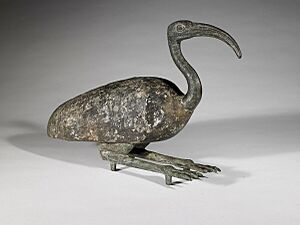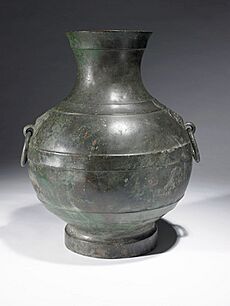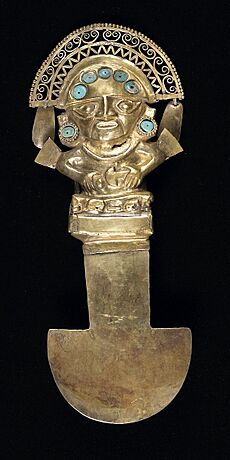Birmingham Museum of Art facts for kids
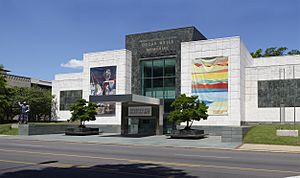
Oscar Wells Memorial entrance to the museum
|
|
| Established | April 1951 |
|---|---|
| Location | 2000 Rev. Abraham Woods Jr. Blvd. North (formerly 8th Avenue North) Birmingham, Alabama, US |
| Type | Municipal art museum |
The Birmingham Museum of Art is a cool place to explore art in Birmingham, Alabama. It has a huge collection of over 24,000 pieces! You can see paintings, sculptures, prints, drawings, and decorative arts from many different cultures. These include art from Asia, Europe, America, Africa, Pre-Columbian times, and Native American groups. The museum also features beautiful Renaissance and Baroque art from the late 1200s to around 1750.
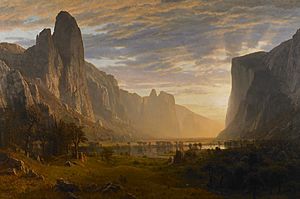
The City of Birmingham owns the Birmingham Museum of Art. It covers about 3.9 acres in the city's cultural area. The main building was built in 1959. It was designed by architects Warren, Knight & Davis. Later, in 1993, Edward Larrabee Barnes from New York led a big renovation and expansion. The museum now covers 180,000 square feet, including an outdoor sculpture garden.
The museum is also part of the Monuments Men and Women Museum Network. This network was started in 2021 by the Monuments Men Foundation for the Preservation of Art.
Contents
- Amazing Art Collections
- African Art: Ancient to Modern
- American Art: From the 1700s to Today
- Art from Alabama: Local Talent
- Asian Art: A Journey Through Cultures
- Contemporary Art: Art of Our Time
- Folk Art: Unique and Self-Taught
- European Art: Old Masters and Beyond
- European Decorative Arts: Beautiful Objects
- Native American Art: Rich Traditions
- Pre-Columbian Art: Ancient Americas
- The Charles W. Ireland Sculpture Garden
- The Clarence B. Hanson Jr. Library: A Research Hub
- Museum History
- See also
Amazing Art Collections
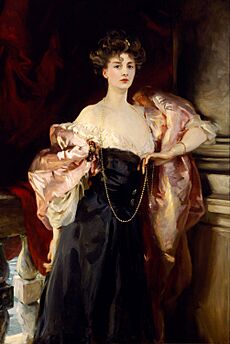

African Art: Ancient to Modern
The museum has almost 2,000 pieces of African art. This collection includes art from the 12th century to today. You can see sculptures, masks, and objects used in rituals. There are also furniture, textiles, pottery, and metal art. Some special items are an Egyptian false door, a Yoruba mask, and a bronze hip pendant from Benin.
American Art: From the 1700s to Today
The museum's American art collection covers the late 1700s to the mid-1900s. It features paintings by artists like Gilbert Stuart, Childe Hassam, and Georgia O'Keeffe. You can also find sculptures by Hiram Powers and Frederic Remington. Important decorative pieces include works by Tiffany Studios and Frank Lloyd Wright. One famous painting is Looking Down Yosemite Valley, California (1865) by Bierstadt. It's considered one of the most important American landscape paintings.
Art from Alabama: Local Talent
Since it opened in 1951, the Birmingham Museum of Art has collected art made in Alabama. Early works included paintings by Hannah Elliott and Carrie Hill. The museum continues to support Alabama artists. In 1995, it held an exhibition called "Made in Alabama." The museum also collects folk art, like paintings, sculptures, quilts, and pottery, made by self-taught artists.
Asian Art: A Journey Through Cultures
The museum's Asian art collection began in 1951 with a gift of Chinese textiles. Now, it has over 4,000 objects from China, Korea, Japan, India, and Southeast Asia. You can see Vietnamese ceramics, Buddhist and Hindu art, lacquer ware, and paintings. Highlights include a rare Ming dynasty temple wall and Tang dynasty tomb figures from China. There's also ancient Jomon pottery from Japan. The museum has the only gallery for Korean art in the Southeast United States.
Contemporary Art: Art of Our Time
This collection shows art from the 1960s to today. It includes paintings, sculptures, videos, and photographs. You'll see works by famous artists like Joan Mitchell, Andy Warhol, and Kerry James Marshall. It also features photos from the civil rights era by Danny Lyon and Gordon Parks.
Folk Art: Unique and Self-Taught
Since 2009, the museum has had a special display of folk art. This includes works by Bill Traylor and Thornton Dial. You can also see amazing quilts by Alabama quilters and other self-taught artists. In 2013, the Robert Cargo Folk Art Collection was given to the museum.
European Art: Old Masters and Beyond
The European art collection includes the Kress Collection of Renaissance Art. This part has Renaissance and Baroque paintings, sculptures, and decorative arts from the late 1200s to around 1750. You can see works by artists like Pietro Perugino and Antonio Canaletto. Other parts of the collection feature 17th-century Dutch paintings and 18th-century British portraits. There are also French paintings from the 1700s and 1800s by artists like Mary Cassatt and Gustave Courbet.
European Decorative Arts: Beautiful Objects
This collection is a big part of the museum's permanent display. It has over 12,000 objects, including ceramics, glass, and furniture. These pieces date from the Renaissance to today. A special part is the only public collection of late 19th-century European cast iron items in the US. The Eugenia Woodward Hitt Collection has 18th-century French art, including furniture and paintings. The Dwight and Lucille Beeson Wedgwood Collection is also very important. It has over 1,400 objects from the Wedgwood factory, showing its history.
Native American Art: Rich Traditions
The museum has a large display of Native American arts. The galleries are set up by region: Eastern Woodlands, Plains, Northwest Coast, and Southwest. You can see many beautiful Navajo blankets and rugs. There's also a large collection of Northwest Coast art and important Pueblo ceramics. The collection also features amazing Plains beadwork and shaman headdresses.
Pre-Columbian Art: Ancient Americas
This collection features amazing objects from Meso-America, Central America, and the Northern Andes. From Meso-America, you can see Zapotec ceramics and objects related to the ancient ballgame. There are also Maya sculptures and jewelry, and Aztec stone sculptures. From ancient Costa Rica, Guatemala, and Panama, you'll find gold jewelry and ceramics. Northern Andean objects include Sican gold vessels and ceremonial knives (tumi). You can also see ceramics from the Moche and Chimu cultures, and Peruvian textiles.
The Charles W. Ireland Sculpture Garden
This outdoor garden has different levels and features sculptures by artists like Fernando Botero and Auguste Rodin. There are also three special artworks made just for the museum. These include Lithos II (1993) by Elyn Zimmerman, which is a water wall. Another is Blue Pools Courtyard (1993) by Valerie Jaudon, with inlaid tile pools. Finally, there's Sol LeWitt's Bands of Color in Various Directions, added in 2001 for the museum's 50th anniversary.
The Clarence B. Hanson Jr. Library: A Research Hub
The museum's library is named after Clarence Bloodworth Hanson Jr. He was a former publisher of the Birmingham News and a museum board member for 24 years. This library is one of the best art research libraries in the southeastern US. It has many books, magazines, and databases about art. The Chellis Wedgwood Library is also here. It's the largest collection in the world about Josiah Wedgwood and his pottery. This makes it a major center for studying Wedgwood in the US.
Museum History
Birmingham Art Club: The Beginning
The museum's story started in 1908 with the Birmingham Art Club. This club wanted to create a public art collection for the people of Birmingham. In 1927, they were able to show their collection in the new Birmingham Public Library. For the next 20 years, the club kept adding to the collection. They also worked to get support for a new museum building.
First Exhibition: A Grand Opening
In September 1950, a special board was created to start the museum. They wanted it to be a place for everyone to learn and have fun. In February 1951, Richard Foster Howard became the first museum director. In April 1951, the new Birmingham Museum of Art held its first public "Opening Exhibition." It was in five unused rooms at City Hall. The exhibition included some pieces from the Art Club's collection. It also had many artworks borrowed from other museums across the Eastern United States. People said it was "the finest showing of great objects of art in the South to date."
New Building: A Home for Art
The success of the first exhibition led to many important gifts. These included Chinese ceramics, Japanese prints, and old master prints. In 1952, the Samuel H. Kress Foundation loaned 29 paintings from the Italian Renaissance. These paintings became the main part of the European art collection. A large gift in 1954 made it possible to build a new museum. Land was bought in 1955, and the design for the new building was given to Warren, Knight & Davis. The Oscar Wells Memorial Building opened on May 3, 1959. Later, the Kress Foundation gave two more important gifts. In 1959, they gave a collection of Renaissance furniture. In 1960, they gave the Italian paintings that were already on loan, plus eight more. The next year, the American Cast Iron Pipe Company loaned its Lamprecht Collection of German cast-iron objects. This is the largest collection of its kind in the world.
Expansions: Growing Bigger
The museum continued to grow over the years. In 1965, more galleries were added to the west wing. A new east wing was finished in 1967. More land was bought in 1969. In 1974, another addition included rebuilding the east wing with three stories. In 1979, the east wing was updated again. This added a conservation lab and a second public entrance. The next year, gallery space grew by 28,000 square feet. In 1986, another big expansion was planned. Architect Edward Larrabee Barnes was chosen to design it. This plan included a new outdoor sculpture garden and 50,000 square feet of new exhibition space. This brought the total size to 180,000 square feet.
See also
 In Spanish: Museo de Arte de Birmingham para niños
In Spanish: Museo de Arte de Birmingham para niños
- List of largest art museums
- North American Reciprocal Museums


